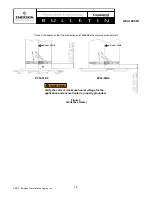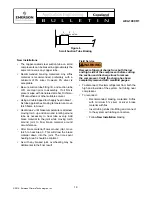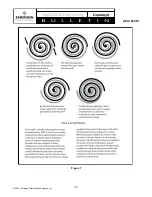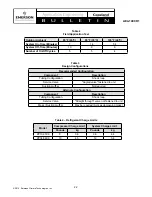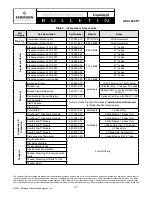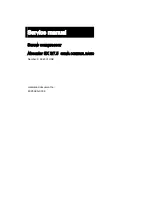
10
© 2015 Emerson Climate Technologies, Inc.
AE4-1400 R1
Three Phase Scroll Compressor Electrical Phasing
Copeland Scroll compressors, like several other types
of compressors, will only compress gas in one rotational
direction. Direction of rotation is not an issue with
single phase compressors since they will always start
and run in the proper direction (except as described in
the section “Brief Power Interruptions”). Three phase
compressors will rotate in either direction depending
upon phasing of the power. Since there is a 50% chance
of connecting power in such a way as to cause rotation in
the reverse direction,
it is important to include notices
and instructions in appropriate locations on the
equipment to ensure that proper rotation direction is
achieved when the system is installed and operated.
Verification of proper rotation direction is made by
observing that suction pressure drops and discharge
pressure rises when the compressor is energized.
Reverse rotation will result in no pressure differential as
compared to normal values. A compressor running in
reverse will sometimes make an abnormal sound.
There is no negative impact on durability caused by
operating three phase Copeland Scroll compressors in
the reversed direction for a short period of time (under
one hour). After several minutes of reverse operation,
the compressor’s internal overload protector will trip
shutting off the compressor. If allowed to repeatedly
restart and run in reverse without correcting the
situation, the compressor bearings will be permanently
damaged because of oil loss to the system.
Brief Power Interruptions
Brief power interruptions (less than ½ second) may
result in powered reverse rotation of single-phase
Copeland Scroll compressors. This occurs because
high-pressure discharge gas expands backward
through the scrolls during interruption, causing the scroll
to orbit in the reverse direction. When power is reapplied
while reverse rotation is occurring, the compressor may
continue to run in the reverse direction for some time
before the compressor’s internal overload trips. This will
not cause any damage to the compressor, and when
the internal overload resets, the compressor will start
and run normally.
To avoid disruption of operation, an electronic control
that can sense brief power interruptions may be used
to lock out the compressor for a short time. This control
could be incorporated in other system controls (such
as defrost control board or the system thermostat), or
can be a stand-alone control. Functional specifications
for this control as well as a suggested wiring diagram
are shown in
Figure 3
. No time delay is necessary for
three phase models since the motor starting torque is
high enough to overcome reverse rotation.
A start kit (specified start capacitor and relay) is another
effective means of mitigating a powered reverse
condition that is caused by a brief power interruption.
In addition, SecureStart has the ability to detect when
the compressor is running backwards. When running
backwards is detected by SecureStart, it will de-energize
the compressor and restart it after three minutes.
Tandem Compressors
At this time, ZPK*6 compressors have not been qualified
for tandem applications.
Maximum Tilt Angle
OEMs and end-users often ask about the maximum
allowable tilt angle of the compressor. Some
applications, such as transportation air-conditioning or
mobile radar applications, may require the compressor
to operate at some angle from vertical. Or, service
personnel may be required to maneuver a unit through
a stairwell or other cramped area that might require
tilting the unit. The maximum allowable tilt angles from
horizontal are summarized below:
Max Tilt Angle With Compressor Running = 15°
Max Tilt Angle With Compressor Not Running = 60°
APPLICATION TESTS
Application Test Summary
There are a minimal number of tests the system
designer will want to run to ensure the system operates
as designed. These tests should be performed during
system development and are dependent on the
system type and amount of refrigerant charge. These
application tests are to help identify gross errors in
system design that may produce conditions that could
lead to compressor failure. The Continuous Floodback
Test and Field Application Test, both outlined below, are
two tests to run to help verify the design. When to run
these tests can be summarized as follows:
Continuous Floodback:
Required on all heatpumps.
Field Application Test:
Required for any unit where both the design system


















